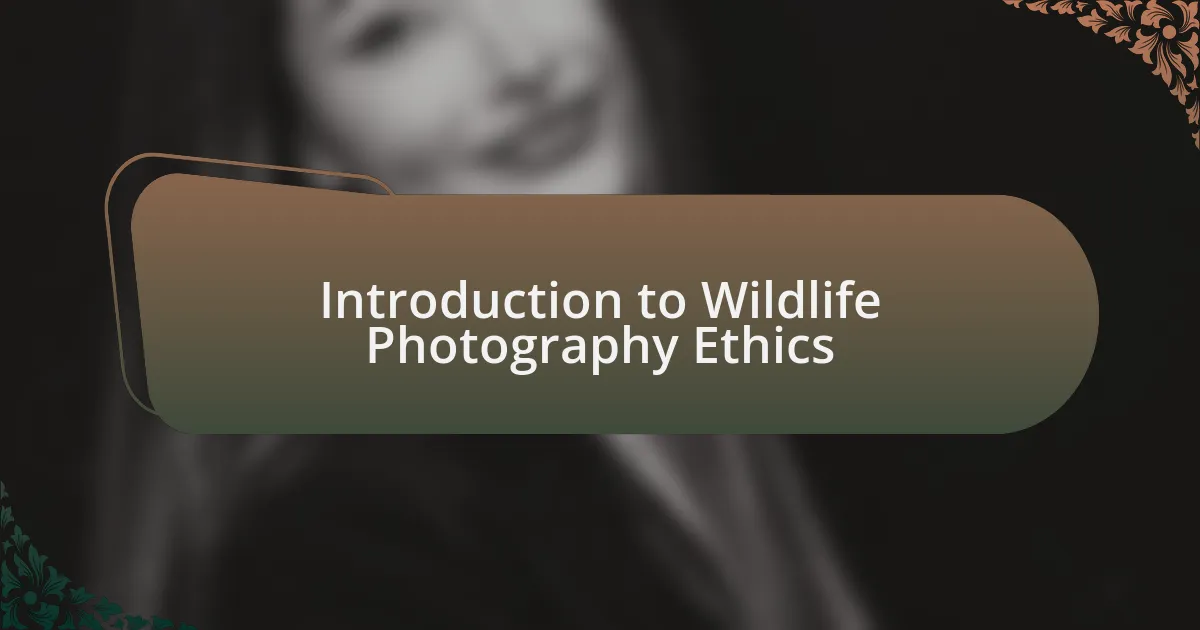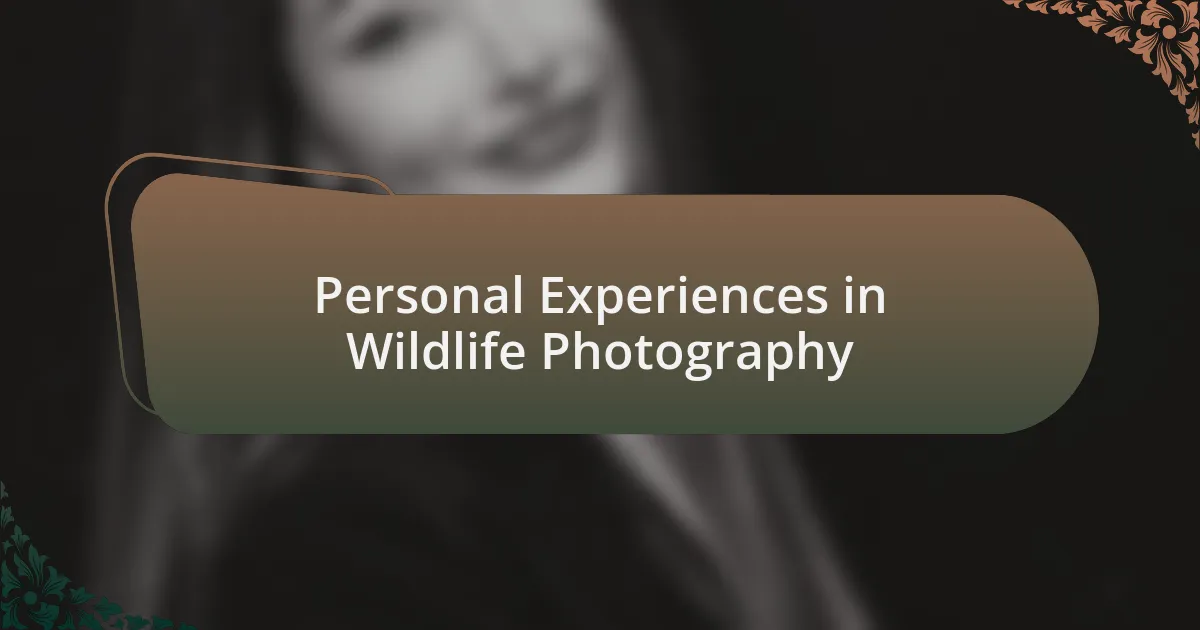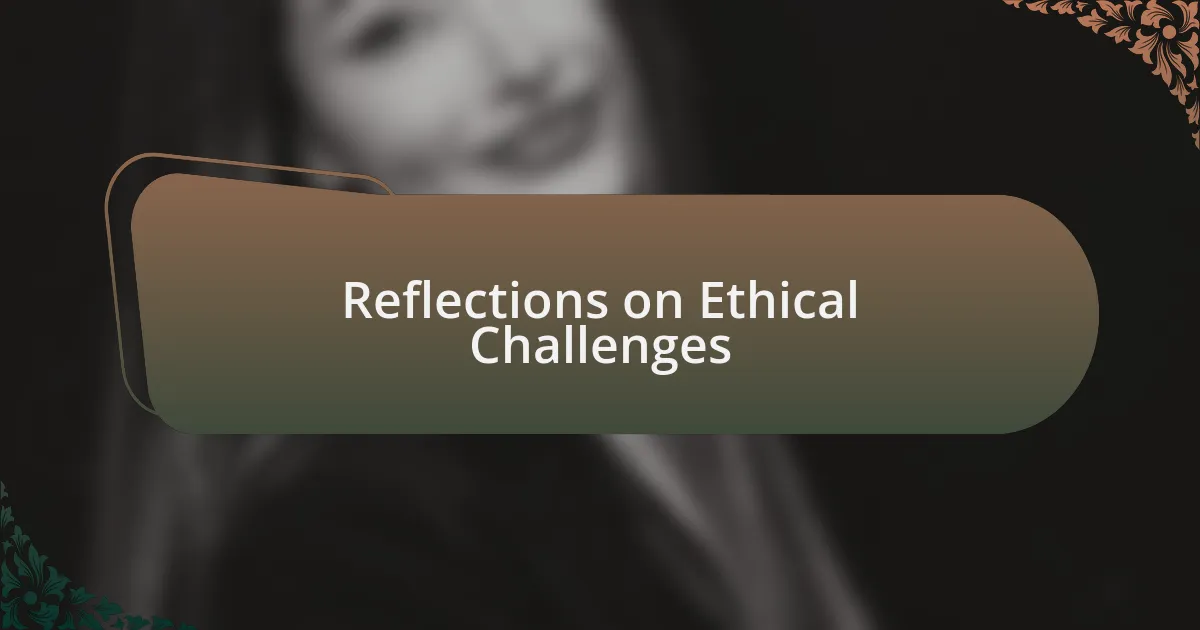Key takeaways:
- Wildlife photography requires a balance between capturing stunning images and respecting the welfare of the subjects, emphasizing the need for patience and restraint.
- Ethical practices in photography foster trust within the community and promote conservation, encouraging accurate representation of wildlife and inspiring audience empathy.
- Personal experiences highlight the importance of observing wildlife without intrusion, reinforcing the idea that presence and appreciation can be more fulfilling than photographing every moment.
- Photographers must reflect on the potential disruptions their actions may cause to wildlife, prioritizing the well-being of the creatures they aim to celebrate.

Introduction to Wildlife Photography Ethics
Wildlife photography is not just about capturing stunning images; it also involves a deep sense of responsibility towards the subjects we photograph. I remember the first time I encountered a family of deer in their natural habitat, feeling both awe and guilt as I realized my presence could disrupt their lives. This moment made me question: how can we interact with these animals through our lens while minimizing our impact on their environment?
Ethics in wildlife photography is about respecting the boundaries of nature. I’ve often heard discussions among photographers about the fine line between wildlife observation and intrusion. It can be tempting to chase after that perfect shot, but I’ve learned that patience and restraint lead to more authentic moments. What happens when our desire for a breathtaking photograph results in stress for the animal?
As photographers, we have a choice: to become advocates for wildlife or unwitting participants in their disruption. Reflecting on my experiences, I often ponder the implications of our actions on future generations of wildlife and photographers alike. Can we capture the beauty of nature while ensuring it thrives for years to come? This fundamental question keeps me grounded in my pursuit of ethical wildlife photography.

Importance of Ethics in Photography
Ethics in photography serves as a moral compass guiding our actions behind the lens. I fondly recall a day in the field when I found myself in a delicate situation; a mother bird was feeding her chicks, and I felt an intense urge to capture this intimate moment. However, I hesitated, recognizing that any abrupt movement could scare her away. This reflection highlighted how ethical considerations can often eclipse our desire for stunning images, reminding me that the welfare of the subject must always come first.
Furthermore, embracing ethical practices fosters trust not only with wildlife but also within the photography community. When I share my experiences of respecting nature’s boundaries, I often see a spark of understanding in fellow photographers’ eyes. In doing so, we collectively set a standard that prioritizes conservation and respect over mere aesthetics. It’s fascinating to think: how can we create a culture in wildlife photography that empowers future generations to appreciate and protect the very subjects we cherish?
Lastly, the importance of ethics in photography extends beyond individual encounters; it shapes the narrative we present to our audience. For instance, I remember feeling disheartened seeing images that sensationalized animal distress for the sake of drama. This not only misrepresents nature but also desensitizes viewers to real issues affecting wildlife. By upholding ethical standards, we contribute to a more accurate depiction of wildlife and encourage empathy, ultimately inspiring our audience to care about the natural world as much as we do.

Respecting Wildlife and Their Habitats
When it comes to wildlife photography, respecting the habitats of our subjects becomes crucial. I remember a trip to a coastal area where I stumbled upon a sensitive nesting site for sea turtles. The temptation to get closer for the perfect shot was strong, but I chose to maintain my distance. Watching them from afar provided me with a sense of peace, and I realized that the real beauty lies in observing without intrusion.
It’s essential to recognize that our presence can have profound effects on wildlife. One chilly morning, I encountered a deer at dawn, its breath visible in the crisp air. Instead of raising my camera, I took a moment to simply enjoy the scene. That choice reinforced for me the principle that we are guests in their world, and our actions can impact their safety and well-being. Isn’t it amazing how a few moments of patience can lead to deeper appreciation?
Furthermore, the consequences of our actions extend beyond the immediate moment. After witnessing the distress in a mother fox as she fled from a loud group of photographers, I felt a wave of guilt wash over me. This experience taught me that every image we capture should come with a responsibility to ensure the welfare of our subjects. How can we claim to appreciate wildlife if we’re not willing to protect it? In engaging thoughtfully with the environment, we not only elevate our art but also honor the lives we seek to portray.

Personal Experiences in Wildlife Photography
On one occasion, while hiking through a dense forest, I spotted a family of foxes playing in a clearing. Instead of rushing in with my camera, I paused to marvel at their natural behavior. That instinct to simply watch rather than photograph led me to realize how often we miss the richness of experiences by prioritizing the image over the moment.
During another expedition, I accidentally disrupted a nesting bird while trying to capture its vibrant plumage. The swift flight of the parent bird was a bitter reminder that my presence could potentially harm. It left me questioning: Is the fleeting satisfaction of a stunning photograph worth the stress it might cause to the subjects? I began to appreciate that some of my most fulfilling experiences don’t require a shutter click; just being present is enough.
There was a time when I was positioned along a riverbank, hoping to capture the perfect shot of a pair of otters. As I waited silently, they began to play and swim, completely unaware of my presence. In that moment, I felt a deep connection with the wildlife around me. Reflecting on this, I wondered how often we lose sight of the connection in our quest for the perfect shot, when sometimes, the greatest treasures lie in the moments we simply observe.

Reflections on Ethical Challenges
As I navigated a national park one afternoon, I witnessed a beautiful interaction between a mother deer and her fawn. I was tempted to grab my camera, but instead, I chose to sit quietly until they retreated into the trees. This experience highlighted for me the ethical challenge of balance—how can we document nature without becoming invasive?
Another time, I found myself in a position to photograph a majestic eagle perched nearby. Yet, as I adjusted my lens, I noticed how my movements were startling other birds in the area. It made me pause: how often do we prioritize a striking image at the expense of the delicate ecosystem around us? I questioned whether my artistry was worth the potential disruption to wildlife.
On a chilly morning, I set out to capture the first light painting a serene lake. I accidentally wandered into the path of a family of geese, and they honked in alarm, scattering. That moment stirred feelings of guilt and regret within me. Was I making choices that put my passion above the well-being of the creatures I sought to celebrate? These experiences compel me to reflect on the responsibility that comes with wildlife photography and how important it is to tread thoughtfully.